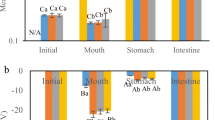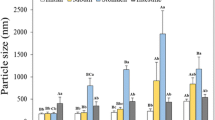Abstract
This study examines the influence of different food-grade n-3 PUFA-enriched simple emulsion (SE), double emulsion (DE) and gelled double emulsion (GDE) delivery systems on the extent of lipolysis, antioxidant capacity and the bioaccessibility of hydroxytyrosol (HTy). GDE emulsion offered better protection for HTy (89%) than the other systems (79% in SE and DE). The reducing capacity of the emulsions containing HTy were not altered during oral digestion. However, “in vitro” gastric and intestinal phases significantly reduced the antioxidant activity of all systems. The structural and physical state of GDE entailed a slowing-down of triacylglyceride hydrolysis (36.4%) in comparison with that of SE and DE (22.7 and 24.8% for SE and DE, respectively).

Similar content being viewed by others
References
Ahn J, Grun IU, Fernando LN (2002) Antioxidant properties of natural plant extracts containing polyphenolic compounds in cooked ground beef. J Food Sci 67:1364–1369. doi:10.1111/j.1365-2621.2002.tb10290.x
Arroyo R, Sánchez-Muniz FJ, Cuesta C, Burguillo FJ, Sánchez-Montero JM (1996) Hydrolysis of used frying palm olein and sunflower oil catalyzed by porcine pancreatic lipase. Lipids 31:1133–1139. doi:10.1007/bf02524287
Cofrades S, Antoniou I, Solas MT, Herrero AM, Jiménez-Colmenero F (2013) Preparation and impact of multiple (water-in-oil-in-water) emulsions in meat systems. Food Chem 141:338–346. doi:10.1016/j.foodchem.2013.02.097
De Leonardis A, Aretini A, Alfano G, Macciola V, Ranalli G (2008) Isolation of a hydroxytyrosol-rich extract from olive leaves (Olea Europaea L.) and evaluation of its antioxidant properties and bioactivity. Eur Food Res Technol 226:653–659. doi:10.1007/s00217-007-0574-3
DeJong S, Lanari MC (2009) Extracts of olive polyphenols improve lipid stability in cooked beef and pork: contribution of individual phenolics to the antioxidant activity of the extract. Food Chem 116:892–897. doi:10.1016/j.foodchem.2009.03.053
Dobarganes MC, Velasco J, Dieffenbacher A (2000) Determination of polar compounds, polymerized and oxidized triacylglycerols, and diacylglycerols in oils and fats: results of collaborative studies and the standardized method (Technical report). Pure Appl Chem 72:1563. doi:10.1351/pac200072081563
Fki I, Allouche N, Sayadi S (2005) The use of polyphenolic extract, purified hydroxytyrosol and 3,4-dihydroxyphenyl acetic acid from olive mill wastewater for the stabilization of refined oils: a potential alternative to synthetic antioxidants. Food Chem 93:197–204. doi:10.1016/j.foodchem.2004.09.014
Flaiz L, Freire M, Cofrades S, Mateos R, Weiss J, Jimenez-Colmenero F, Bou R (2016) Comparison of simple, double and gelled double emulsions as hydroxytyrosol and n-3 fatty acid delivery systems. Food Chem 213:49–57. doi:10.1016/j.foodchem.2016.06.005
Garti N (1997) Double emulsions—scope, limitations and new achievements. Colloid Surf A 123–124:233–246. doi:10.1016/S0927-7757(96)03809-5
Gómez-Guillén MC, Giménez B, Lopez-Caballero ME, Montero MP (2011) Functional and bioactive properties of collagen and gelatin from alternative sources: a review. Food Hydrocoll 25:1813–1827. doi:10.1016/j.foodhyd.2011.02.007
Gonzalez-Santiago M et al (2006) One-month administration of hydroxytyrosol, a phenolic antioxidant present in olive oil, to hyperlipemic rabbits improves blood lipid profile, antioxidant status and reduces atherosclerosis development. Atherosclerosis 188:35–42. doi:10.1016/j.atherosclerosis.2005.10.022
Guo Q, Ye A, Lad M, Dalgleish D, Singh H (2014) Effect of gel structure on the gastric digestion of whey protein emulsion gels. Soft Matter 10:1214–1223. doi:10.1039/c3sm52758a
Jiménez-Colmenero F (2013) Potential applications of multiple emulsions in the development of healthy and functional foods. Food Res Int 52:64–74. doi:10.1016/j.foodres.2013.02.040
Jiménez-Colmenero F, Salcedo-Sandoval L, Bou R, Cofrades S, Herrero AM, Ruiz-Capillas C (2015) Novel applications of oil-structuring methods as a strategy to improve the fat content of meat products. Trends Food Sci Technol 44:177–188
Jo H, Kim M, Lee J, Kim H, Song YO (2013) Anti-atherogenic properties of emulsified perilla oil (EPO) in apo E KO mice and plasma lipid lowering effects of rice porridge containing EPO in healthy young adults. Food Sci Biotechnol 22:79–85. doi:10.1007/s10068-013-0011-2
Li J, Cheng Y, Tatsumi E, Saito M, Yin L (2014) The use of W/O/W controlled-release coagulants to improve the quality of bittern-solidified tofu. Food Hydrocoll 35:627–635. doi:10.1016/j.foodhyd.2013.08.002
Lindblad BS (1988) Perinatal nutrition. Academic Press Inc., Orlando
Lobato-Calleros C, Sosa-Pérez A, Rodríguez-Tafoya J, Sandoval-Castilla O, Pérez-Alonso C, Vernon-Carter EJ (2008) Structural and textural characteristics of reduced-fat cheese-like products made from W1/O/W2 emulsions and skim milk. LWT-Food Sci Technol 41:1847–1856. doi:10.1016/j.lwt.2008.01.006
Mao L, Miao S (2015) Structuring food emulsions to improve nutrient delivery during digestion. Food Eng Rev 7:439–451. doi:10.1007/s12393-015-9108-0
Marze S (2013) Bioaccessibility of nutrients and micronutrients from dispersed food systems: impact of the multiscale bulk and interfacial structures. Crit Rev Food Sci Nutr 53:76–108. doi:10.1080/10408398.2010.525331
McClements DJ, Decker EA (2000) Lipid oxidation in oil-in-water emulsions: impact of molecular environment on chemical reactions in heterogeneous food systems. J Food Sci 65:1270–1282. doi:10.1111/j.1365-2621.2000.tb10596.x
McClements DJ, Li Y (2010) Structured emulsion-based delivery systems: controlling the digestion and release of lipophilic food components. Adv Colloid Interf Sci 159:213–228. doi:10.1016/j.cis.2010.06.010
Minekus M et al (2014) A standardised static in vitro digestion method suitable for food—an international consensus. Food Funct 5:1113–1124
Olivero-David R et al (2011) Effect of thermally oxidized oil and fasting status on the short-term digestibility of ketolinoleic acids and total oxidized fatty acids in rats. J Agric Food Chem 59:4684–4691. doi:10.1021/jf1048063
Pazos M, Alonso A, Sanchez I, Medina I (2008) Hydroxytyrosol prevents oxidative deterioration in foodstuffs rich in fish lipids. J Agric Food Chem 56:3334–3340
Pereira-Caro G, Sarriá B, Madrona A, Espartero JL, Escuderos ME, Bravo L, Mateos R (2012) Digestive stability of hydroxytyrosol, hydroxytyrosyl acetate and alkyl hydroxytyrosyl ethers. Int J Food Sci Nutr 63:703–707. doi:10.3109/09637486.2011.652943
Porter CJH, Trevaskis NL, Charman WN (2007) Lipids and lipid-based formulations: optimizing the oral delivery of lipophilic drugs. Nat Rev Drug Discov 6:231–248
Pulido R, Bravo L, Saura-Calixto F (2000) Antioxidant activity of dietary polyphenols as determined by a modified ferric reducing/antioxidant power assay. J Agric Food Chem 48:3396–3402
Sánchez-Muniz FJ, Benedí J, Bastida S, Olivero-David R, Gonzalez-Muñoz MJ (2011) Enzymes and thermally oxidized oils and fats. In: Boskou D, Elmadfa I (eds) Frying of foods: oxidation, nutrient and non-nutrient antioxidants, biologically active compounds and high temperatures. CRC Press, Taylor and Francis group LLC, Boca Raton, pp 105–155
Wang Z, Neves MA, Kobayashi I, Uemura K, Nakajima M (2013) Preparation, characterization, and in vitro gastrointestinal digestibility of oil-in-water emulsion-agar gels. Biosci Biotechnol Biochem 77:467–474. doi:10.1271/bbb.120659
Weiss J, Scherze I, Muschiolik G (2005) Polysaccharide gel with multiple emulsion. Food Hydrocoll 19:605–615. doi:10.1016/j.foohyd.2004.10.023
WHO/FAO Expert Consultation (2003) Diet, nutrition and the prevention of chronic diseases. World Health Organization. http://www.who.int/dietphysicalactivity/publications/trs916/download/en/. Accessed 15 Feb 2017
Wooster TJ, Day L, Xu M, Golding M, Oiseth S, Keogh J, Clifton P (2014) Impact of different biopolymer networks on the digestion of gastric structured emulsions. Food Hydrocoll 36:102–114. doi:10.1016/j.foodhyd.2013.09.009
Yang M, Liu F, Tang C-H (2013) Properties and microstructure of transglutaminase-set soy protein-stabilized emulsion gels. Food Res Int 52:409–418. doi:10.1016/j.foodres.2011.11.012
Zetzl AK, Marangoni AG, Barbut S (2012) Mechanical properties of ethylcellulose oleogels and their potential for saturated fat reduction in frankfurters. Food Funct 3:327–337. doi:10.1039/C2FO10202A
Zhang R, Zhang Z, Zhang H, Decker EA, McClements DJ (2015) Influence of emulsifier type on gastrointestinal fate of oil-in-water emulsions containing anionic dietary fiber (pectin). Food Hydrocoll 45:175–185. doi:10.1016/j.foodhyd.2014.11.020
Acknowledgements
R. B. thanks the Spanish Ministry of Economy and Competitiveness for his contract through the Ramón y Cajal Program and A. G. for the BES-2012-054752 (FPI) pre-doctoral fellowship. This research was supported under Project AGL2011-29644-C02-01, AGL2014-53207-C2-1-R and AGL2014-53207-C2-2-R of the Plan Nacional de Investigación Cientifica, Desarrollo e Innovación Tecnologica (I + D+I), Ministerio de Economia y Competitividad, and Intramural project CSIC: 201470E056.
Author information
Authors and Affiliations
Corresponding author
Additional information
Susana Cofrades and Ricard Bou contributed equally to this work.
Rights and permissions
About this article
Cite this article
Cofrades, S., Bou, R., Flaiz, L. et al. Bioaccessibility of hydroxytyrosol and n-3 fatty acids as affected by the delivery system: simple, double and gelled double emulsions. J Food Sci Technol 54, 1785–1793 (2017). https://doi.org/10.1007/s13197-017-2604-x
Revised:
Accepted:
Published:
Issue Date:
DOI: https://doi.org/10.1007/s13197-017-2604-x




